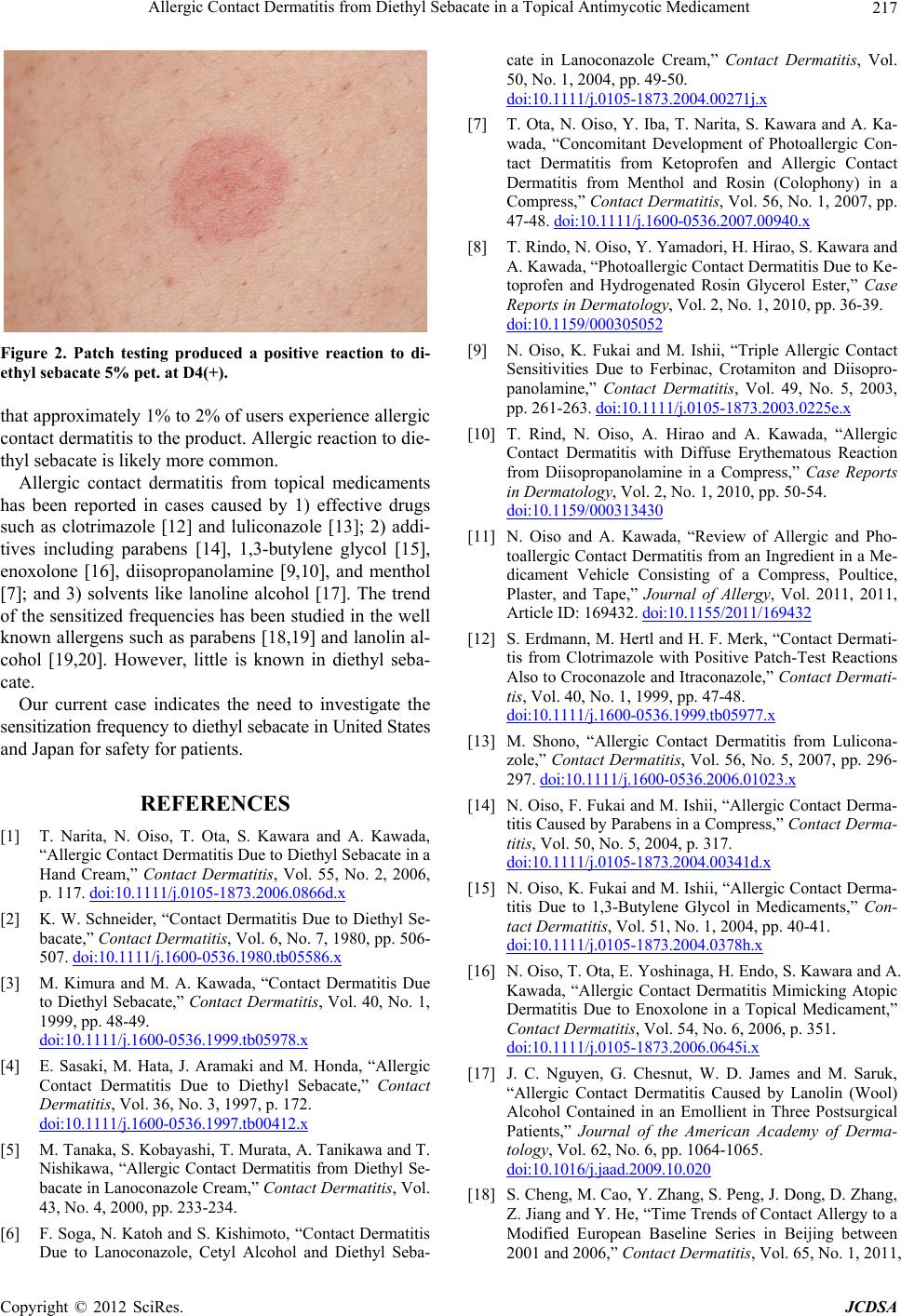
Allergic Contact Dermatitis from Diethyl Sebacate in a Topical Antimycotic Medicament 217
Figure 2. Patch testing produced a positive reaction to di-
ethyl sebacate 5% pet. at D4(+).
that approximately 1% to 2% of users experience allergic
contact dermatitis to the product. Allergic reaction to die-
thyl sebacate is likely more common.
Allergic contact dermatitis from topical medicaments
has been reported in cases caused by 1) effective drugs
such as clotrimazole [12] and luliconazole [13]; 2) addi-
tives including parabens [14], 1,3-butylene glycol [15],
enoxolone [16], diisopropanolamine [9,10], and menthol
[7]; and 3) solvents like lanoline alcohol [17]. The trend
of the sensitized frequencies has been studied in the well
known allergens such as parabens [18,19] and lanolin al-
cohol [19,20]. However, little is known in diethyl seba-
cate.
Our current case indicates the need to investigate the
sensitization frequency to diethyl sebacate in United States
and Japan for safety for patients.
REFERENCES
[1] T. Narita, N. Oiso, T. Ota, S. Kawara and A. Kawada,
“Allergic Contact Dermatitis Due to Diethyl Sebacate in a
Hand Cream,” Contact Dermatitis, Vol. 55, No. 2, 2006,
p. 117. doi:10.1111/j.0105-1873.2006.0866d.x
[2] K. W. Schneider, “Contact Dermatitis Due to Diethyl Se-
bacate,” Contact Dermatitis, Vol. 6, No. 7, 1980, pp. 506-
507. doi:10.1111/j.1600-0536.1980.tb05586.x
[3] M. Kimura and M. A. Kawada, “Contact Dermatitis Due
to Diethyl Sebacate,” Contact Dermatitis, Vol. 40, No. 1,
1999, pp. 48-49.
doi:10.1111/j.1600-0536.1999.tb05978.x
[4] E. Sasaki, M. Hata, J. Aramaki and M. Honda, “Allergic
Contact Dermatitis Due to Diethyl Sebacate,” Contact
Dermatitis, Vol. 36, No. 3, 1997, p. 172.
doi:10.1111/j.1600-0536.1997.tb00412.x
[5] M. Tanaka, S. Kobayashi, T. Murata, A. Tanikawa and T.
Nishikawa, “Allergic Contact Dermatitis from Diethyl Se-
bacate in Lanoconazole Cream,” Contact Dermatitis, Vol.
43, No. 4, 2000, pp. 233-234.
[6] F. Soga, N. Katoh and S. Kishimoto, “Contact Dermatitis
Due to Lanoconazole, Cetyl Alcohol and Diethyl Seba-
cate in Lanoconazole Cream,” Contact Dermatitis, Vol.
50, No. 1, 2004, pp. 49-50.
doi:10.1111/j.0105-1873.2004.00271j.x
[7] T. Ota, N. Oiso, Y. Iba, T. Narita, S. Kawara and A. Ka-
wada, “Concomitant Development of Photoallergic Con-
tact Dermatitis from Ketoprofen and Allergic Contact
Dermatitis from Menthol and Rosin (Colophony) in a
Compress,” Contact Dermatitis, Vol. 56, No. 1, 2007, pp.
47-48. doi:10.1111/j.1600-0536.2007.00940.x
[8] T. Rindo, N. Oiso, Y. Yamadori, H. Hirao, S. Kawara and
A. Kawada, “Photoallergic Contact Dermatitis Due to Ke-
toprofen and Hydrogenated Rosin Glycerol Ester,” Case
Reports in Dermatology, Vol. 2, No. 1, 2010, pp. 36-39.
doi:10.1159/000305052
[9] N. Oiso, K. Fukai and M. Ishii, “Triple Allergic Contact
Sensitivities Due to Ferbinac, Crotamiton and Diisopro-
panolamine,” Contact Dermatitis, Vol. 49, No. 5, 2003,
pp. 261-263. doi:10.1111/j.0105-1873.2003.0225e.x
[10] T. Rind, N. Oiso, A. Hirao and A. Kawada, “Allergic
Contact Dermatitis with Diffuse Erythematous Reaction
from Diisopropanolamine in a Compress,” Case Reports
in Dermatology, Vol. 2, No. 1, 2010, pp. 50-54.
doi:10.1159/000313430
[11] N. Oiso and A. Kawada, “Review of Allergic and Pho-
toallergic Contact Dermatitis from an Ingredient in a Me-
dicament Vehicle Consisting of a Compress, Poultice,
Plaster, and Tape,” Journal of Allergy, Vol. 2011, 2011,
Article ID: 169432. doi:10.1155/2011/169432
[12] S. Erdmann, M. Hertl and H. F. Merk, “Contact Dermati-
tis from Clotrimazole with Positive Patch-Test Reactions
Also to Croconazole and Itraconazole,” Contact Dermati-
tis, Vol. 40, No. 1, 1999, pp. 47-48.
doi:10.1111/j.1600-0536.1999.tb05977.x
[13] M. Shono, “Allergic Contact Dermatitis from Lulicona-
zole,” Contact Dermatitis, Vol. 56, No. 5, 2007, pp. 296-
297. doi:10.1111/j.1600-0536.2006.01023.x
[14] N. Oiso, F. Fukai and M. Ishii, “Allergic Contact Derma-
titis Caused by Parabens in a Compress,” Contact Derma-
titis, Vol. 50, No. 5, 2004, p. 317.
doi:10.1111/j.0105-1873.2004.00341d.x
[15] N. Oiso, K. Fukai and M. Ishii, “Allergic Contact Derma-
titis Due to 1,3-Butylene Glycol in Medicaments,” Con-
tact Dermatitis, Vol. 51, No. 1, 2004, pp. 40-41.
doi:10.1111/j.0105-1873.2004.0378h.x
[16] N. Oiso, T. Ota, E. Yoshinaga, H. Endo, S. Kawara and A.
Kawada, “Allergic Contact Dermatitis Mimicking Atopic
Dermatitis Due to Enoxolone in a Topical Medicament,”
Contact Dermatitis, Vol. 54, No. 6, 2006, p. 351.
doi:10.1111/j.0105-1873.2006.0645i.x
[17] J. C. Nguyen, G. Chesnut, W. D. James and M. Saruk,
“Allergic Contact Dermatitis Caused by Lanolin (Wool)
Alcohol Contained in an Emollient in Three Postsurgical
Patients,” Journal of the American Academy of Derma-
tology, Vol. 62, No. 6, pp. 1064-1065.
doi:10.1016/j.jaad.2009.10.02 0
[18] S. Cheng, M. Cao, Y. Zhang, S. Peng, J. Dong, D. Zhang,
Z. Jiang and Y. He, “Time Trends of Contact Allergy to a
Modified European Baseline Series in Beijing between
2001 and 2006,” Contact Dermatitis, Vol. 65, No. 1, 2011,
Copyright © 2012 SciRes. JCDSA